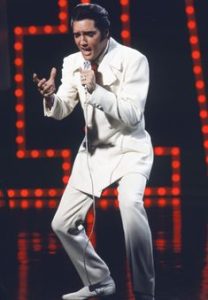By early 1976,Elvis hadn’t set foot in a studio in over a year.His label,RCA,had all but exhausted their existing material and was desperate for new tracks. Years earlier the company had suggested installing a recording setup at Presley’s Graceland home as a way of capturing his constant creativity.By the mid-’70s they insisted on home recording as a last resort to wring some material from him. “It was really hard to get him to record, so this was a way to lure him.”
Installing RCA’s mobile setup in the den at Graceland (a.k.a. “The Jungle Room”),Presley cut sessions in February and October of 1976 that would prove to be his last.
Although Elvis’ longtime producer Felton Jarvis was there to supervise,the home setup didn’t exactly encourage Elvis’s work ethic. It was almost, not haphazard exactly,but pretty much serendipitous as to what he was doing during the course of the sessions.He was there, but then he would disappear for hours at a time,he would go upstairs or wherever.”
When Elvis finally did focus he cut an interesting grab bag of songs.The mix of material ranged from Irish folk standards (“Danny Boy”) to odd disco-flavored numbers (“Moody Blue”). Elsewhere,he worked up passes at new songs, “It’s Easy For You” an emotionally charged narrative penned for him specifically by Broadway tunesmiths Andrew Lloyd-Weber and Tim Rice,and the somewhat less enthralling Neil Sedaka weeper “Solitaire.”He also ran through some familiar country numbers like “She Thinks I Still Care” and “He’ll Have To Go” — the latter turning out to be the final song Elvis recorded.

Even during what was something of a personal nadir, there are unmistakable glimpses of Elvis’s blinding talent as both a vocal stylist and interpreter of song. I think there were clearly moments where he caught fire. Because I think the music continued to invigorate him.There’s genuine feeling at times.
Material from these sessions — including alternate versions, outtakes and studio banter — which were released first as a BMG Fan Club series compact disc, “The Jungle Room Sessions” and then more fully in 2016 as a Sony/Legacy box set “Way Down in the Jungle Room.”
The element that seems most missing from Presley’s performances is his sense of self-direction. For Elvis -one of the great instinctive producers of all time, who shaped his songs through endless vocal performances and sheer will-a malaise had set in.
“This is someone who in his own way-as Jerry Leiber and Mike Stoller say-was a perfectionist of feeling.He was looking for a specific feeling when he recorded. And,at the end,there isn’t anything like that because he isn’t capable of that kind of sustained effort. I think he was just so down.
Unlike Elvis’ sessions in 1956, 1961 or even as late as 1971, the accumulated personal problems — pills ,divorce, depression — had begun to sap not just his energy, but his self-belief.
The precondition for any artist,whatever field, whether it’s music,writing, dancing or acting,is self-belief.And,increasingly, at the end of his life,Elvis no longer believed in himself.He was disappointed in his failure to measure up to himself.

He was so enthralled with gospel and so knowledgeable of it.Not just its historical aspects, both Black and white,but also contemporary gospel. He couldn’t have the same kind of following as he had at his height in popular music.
The gospel aspect is a tantalizing possibility, but Elvis’s passing in August 1977 scotched any such dreams of a new career path.
What remains from the final months of his life are the Jungle Room sessions — both an insightful and heart-wrenching look into the creative life of an artist heading for a tragic end.— CARELESS LOVE,Peter Guralnick
CARELESS LOVE,Peter Guralnick
